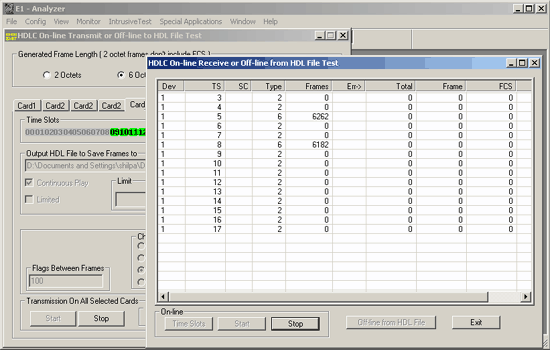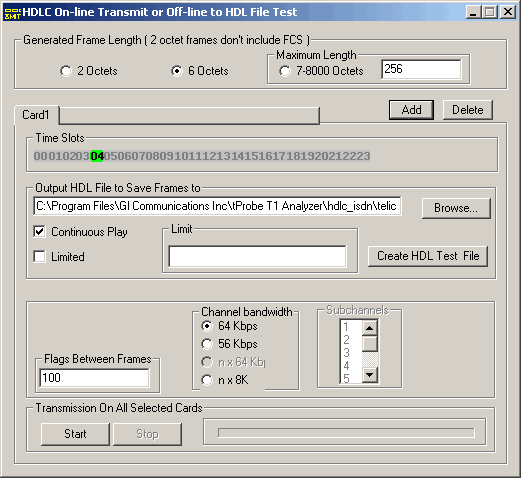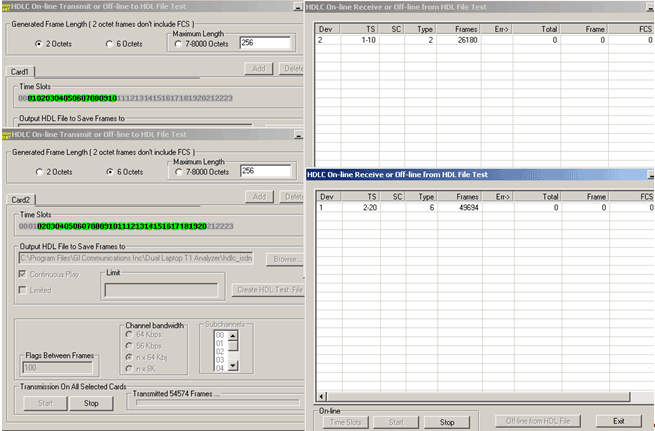Automated HDLC Testing with HDLC Transmit
and Receive Test Applications
Overview
The HDLC Automated Test System consists of two applications: Transmitter application and Receiver application. Each application has real-time and off-line features.
The Transmitter application generates HDLC test frames, transmits them over T1/E1 or records them to an HDL file for subsequent use with other applications. Frames are generated using special algorithms that allow subsequent automated tests that discover frame loss, data modification, frame reordering etc.
The Receiver application can receive frames real-time over T1/E1 or can verify an off-line HDL file for correct frame order and data integrity.
Main Features
- Supports 2-Byte Frame Test, 6-Byte Frame Test, and Variable Frame Test 7-8000 Bytes
- HDLC frames can be transmitted on either a single channel (64 or 56kbps), hyper channels (N*64 or N*56kps), or sub channels (n*8kbps)
- Ability to record the transmitted stream in a HDL file for subsequent use with other applications
- Synchronize automatically in real-time Rx application with the Tx application
Supported HDLC Frame Types
2-Byte Frame Test
- Contains frames with binary encoded numbers from hex 0000 to hex FFFF.
- Does not contain frame check sequence (FCS)
- Sequence can be shorter than 64K, for example, the sequence can be hex 0000 to 01FF or longer (continuous mode) where 0000-FFFF are transmitted in round-robin fashion: 0000 … FFFE, FFFF, 0000, 0001, … FFFF, 0000, …
- Transmitter application part always starts at 0000, while the receiver can start synchronizing at any data, it just expects two byte numbers to be sequential
6-Byte Frame Test
- All frames contain 4 byte numbers with the most significant byte transmitted first + 16 bit FCS (two octets) appended at the end of each frame
- Number range can be hex 00000000 to hex FFFFFFFF (4GB)
- The transmitted sequence can be limited to less then 4GB for example 00000000 to 00FFFFFF or be more than 4GB, while numbers are transmitted in round robin fashion: 00000000, 00000001, …, FFFFFFFF, 00000000, ….
Variable Frame Test 7-8000 Bytes
- Variable frame test consists of 7-MAX, where MAX is 8 to 8000 bytes that include FCS
- Data bytes contain random data, but length always goes in an incremental order, with next frame length one octet longer than previous one till the length reaches MAX.
Working with HDLC Tx Applications
The HDLC Tx dialog allows the users to specify the conditions such as channel bandwidth, timeslots, flags between frames, frame length, continuous or limited transmission options for transmitting tasks as shown in screen below.
- General Frame Length: This option allows choosing the HDLC frame types as explained above.
- Timeslots: allows choosing a single channel, or hyper channels corresponding to each port.
- Continuous and Limited Play: HDLC frames transmission can be continuous or the transmission can be limited to the defined number of frames.
- Create HDL Test File: Records the transmitted HDLC frames as an HDL file
- Flags between Frames: Definition of the number of flags between consecutive HDLC frames.
- Channel Bandwidth: Provides selection of single channel in 64 kbps, or 56 kbps format, and selection of hyper channels (multiple HDLC channels per card) in Nx64 Kbps or Nx56 Kbps. This indicates selection of multiple timeslots each of 64 kbps or 56 Kbps with bits selected. In addition, the data may be transmitted on any of the user-defined bits (contiguous only), in which case, the user must select one of the options and its corresponding DS0 bits under Subchannels 8-56 kbps pane
Working with HDLC Rx Application
Using this application, HDLC frames can be captured real time and the captured frames can be saved to a hdl file (off-line) for offline analysis.
The HDLC Rx Application will accept different patterns on each stream: for example one stream can contain 2-byte test frames, another 6-byte and the 3rd 7+ byte frames. The automated test checks data integrity using sequential numbers for 2 and 6 byte tests and incremental length increase for 7+ byte stream with the constant maximum length that can vary from 8 to 8000 bytes including FCS. It also checks FCS for 6 and 7+ tests. The proper framing is checked for all the frames.
Test results display includes port number, timeslots, subchannels, test type (2, 6 or 7+), frame count, error counts, total error count, frame error count, frame check sequence errors, and data integrity check sequence.
Multiple HDLC Streams
For simultaneous streams with different bandwidth, multiple instances of Transmit or Receive Test dialogues may be invoked. A single timeslot can be used by a single transmit application but there are no restrictions on the number of applications opened for on-line receive tests.




 Back to HDLC Protocol Analyzer Page
Back to HDLC Protocol Analyzer Page